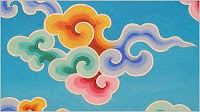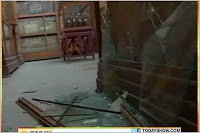Arts-Based Research, Post Qualitative Deleuzian Inquiry, and Other Vignettes from ICQI 2018
Dear Marj,
I attended my first International Congress of Qualitative Inquiry last week. It’s been a while, you know, since you last told me that ICQI takes place right at my doorstep, on my campus. I finally took the plunge and attended some sessions while juggling a busy work schedule.
The opening keynote was a call to action; a call to resist and experiment using critical qualitative inquiry in these troubled times. Bronwyn Davies and Karen Staller spoke eloquently about the “spectacle” we wake up to daily and how to “stitch tattered cloth.”
Prof. Bronwyn Davies’ keynote address on power of spectacle in advancing neoliberal ideology #ICQI2018 #qualitative pic.twitter.com/MTG2SsVq4U
— Sana Rizvi (@sanarizvy) May 17, 2018
I met Sana Rizvi, DeMontfort University, from the UK at my first session. We’ve become distance friends and colleagues as a result of our connection at ICQI 2018. Hope to see you again next year!
.@sanarizvy on Beyond reciprocity, responsibility & respectability: The way forward in feminist research. #icqi2018 pic.twitter.com/YFqs8EHmXn
— Yin Wah Kreher (@yinbk) May 18, 2018
Here are a few highlights from the conference:
-
The use of photovoice as an approach in data collection
Where have I been, Marj? I’ve never heard of this approach until this conference, considering it was first developed by Caroline Wang and Mary Ann Burris in 1992 (Wang, 1999)? Once the mind is enlightened, suddenly, it seems everyone in the conference is using this approach to give voice to marginalized and silenced communities. More accurately, there were many sessions in this conference that referenced this empowering process; typically combining it with other data gathering methods such as focus group discussions or interviews for data triangulation.
I started thinking about how and if I could use this approach in my context.
-
Arts-based research
Art-based research can be defined as the systematic use of the artistic process, the actual making of artistic expressions in all of the different forms of the arts, as a primary way of understanding and examining experience by both researchers and the people that they involve in their studies. These inquiries are distinguished from research activities where the arts may play a significant role but are essentially used as data for investigations that take place within academic disciplines that utilize more traditional scientific, verbal, and mathematic descriptions and analyses of phenomena. (McNiff, 2008 cited in EduTech Wiki by Universite De Geneve)
This is probably not new to you; that I’d be most drawn to this presentation track. I attended as many of these as I could. I was very late for this session, Crystalline Knowledge: Adventures in Found Poetry, and missed most of it. I ended up researching about it online to learn more about the study conducted by Felice Yuen and Sandra Sjollerma, Concordia University. I found their article entitled Evocative Words and Ethical Crafting: Poetic Representation in Leisure Research, which I suspect is what part of their presentation is based on.
… what we know is intimately connected with how we know and with our relationship with research participants (Guba & Lincoln, 2005)
Sjollerma and Yuen’s article (2017) led me to the initial research study of “Journey Women” in which body maps were used to document the healing experiences of eight Aboriginal women from Minwaashin Lodge, a Canadian Aboriginal Women’s Support Center. These participants filled their body maps (large scale outlines of themselves) with images of various aspects of their experience as they worked toward healing. This was done in an arts-based workshop over 2 weekends, followed by a week-long art exhibit after the last workshop session. Phone interviews were conducted with some of these participants to explore the impact of the exhibit on the women’s healing. But the researchers felt that conventional methods of analysis and data representation (“quotations of themes”) did not do justice to the nature of the data they were collecting. They resorted to using 4 data poems to represent the 4 themes.
Marj, this was mind-blowing; if I knew this when I was doing my dissertation study, it would have looked very different!
Another presentation by Kira Hegeman focused on “The Stories of Discarded Objects: Exploring the Pedagogical Potential of Human/Non-Human Intra-Actions through Participatory, Public Art Interventions.” She is still working on her study and referred to “fluid methodology” as entry points to data collection. For more about her work, I’d refer you to her website.
Following her presentation was Christine Woywod’s from the University of Wisconsin-Milwaukee, on “Radical Jewelry Makeover as Restorative Practice Within Material Culture.” Woywod’s study has some similarities with Hegeman’s in that they are both recycling old objects and restoring or transforming them for new purposes. They both also involve the community in the art-making process. Hegelman, the the first artist-in-residence for the UGA Office of Sustainability, “explores material culture, consumption, and interaction through participatory, public art installations.”
The final arts-based research panel used arts to express their identity or to allow others to give voice to their identities. Indeed what better way to explore identity than through art and the arts in its various forms? Corey Reutlinger, Arizona State University, spoke of using American Sign Language to give voice to his “voicelessness” (Listen to My Voice: Investigating the Lived Experiences of “Voiceless” Students); Jeesun Lim, Andong National University, gave voice to art refugees (Small Voices of Art Refugees: I am an Artist); Kathleen Goodyear, Ohio State University, shared her experience of using arts-based activities to allow her undergraduate students to explore their individual and cultural identities (Undergraduates’ Exploration of Their individual and Cultural Identities Through Arts-Based Inquiry: Students’ Perspectives); Torill Vist from Norway, University of Stavanger shared a heartfelt tale of using poetry to explore a change in identity and temperament when she suffered a traumatic health event (Research from the Eye of the Hurricane: Arts-Based Processes in Troubled Times).
-
Posthuman, post qualitative Deleuzian inquiry
I chose to attend this panel of presentations because of my interest in philosophy and my limited knowledge of Deleuze and Guattari’s works. I knew it was going to stretch my thinking. Indeed, it was everything I expected, and did not expect. [Interesting Bit of Info: By then (Saturday, final day of conference), I also noticed that many participants adopted the style of reading from their papers, literally.]Elizabeth St. Pierre’s paper helped me to think differently about research, collaboration, and about the ethics of creation/creating/making in a liminal space where the “I’ constantly disappears.
From what I gleaned from the panelists, the post-structuralist, postmodern qualitative research approach they talked about is inspired by the writings of Deleuze and Guattari. Both scholars advocated against thinking in binary terms, and proposed seeing continuities between the human and nonhuman, the material and nonmaterial, linearity and non-linearity, art/science and other binary concepts (Note: see Kira Hegeman’s study on “The Stories of Discarded Objects: Exploring the Pedagogical Potential of Human/Non-Human Intra-Actions through Participatory, Public Art Interventions). Deleuze sees immanence as that which exists and embodies; there should be no opposing concepts of life and creation, that is, death and non-creation. Instead, on a plane of immanence, life embodies and includes death. When applied to research, there is no one best method or form of research. Whether painting or writing, an act of being or doing is based on that which dwells within. Collaboration, working with others, is at once “beautiful and chaotic” — a description obtained from Wyatt, Gale, Gannon, Davies, Denzin and S. Pierre’s article on their collaborative writing effort (2014) — where time and space is not static:
the complex multiplicities of our singular beings were manifest at the same time as we explored our shared existence as part of the same Being. Shared and therefore messy. As Jane Speedy wrote of J and K’s nomadic work together: “Dust storms. I anticipated dust storms from the outset” (Gale, Speedy, & Wyatt, 2010, p. 23)
I wanted to learn more about the use of digital tools for qualitative research, but not having data at this point to analyze, the sessions didn’t resonate with me so much. In fact, some of the titles sounded interesting, one of these was “When Thomas Meets Watson: The Use of Technology in Social Science Researches” (Carla Dieguez & Rodrigo Souza).
Knowing now how this conference works better positions me to navigate it more strategically the next time so as to learn the most from it.












